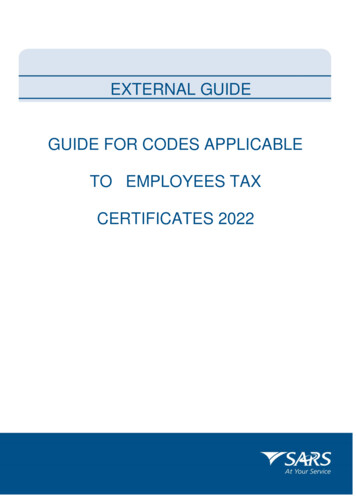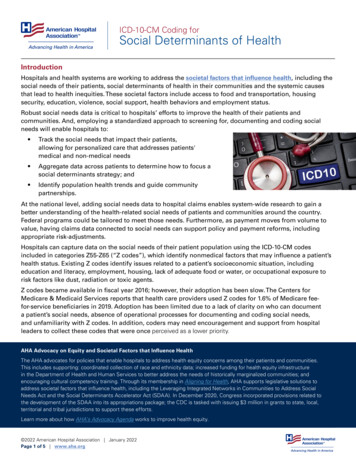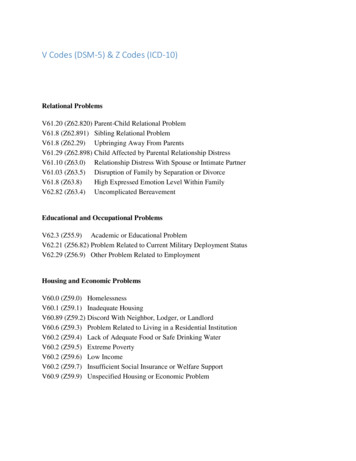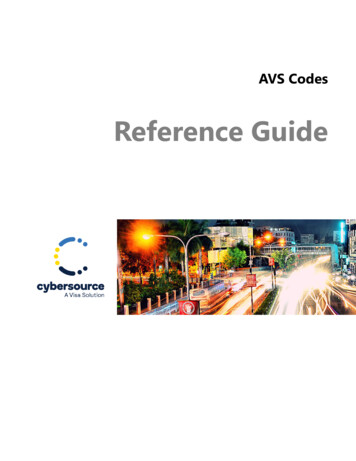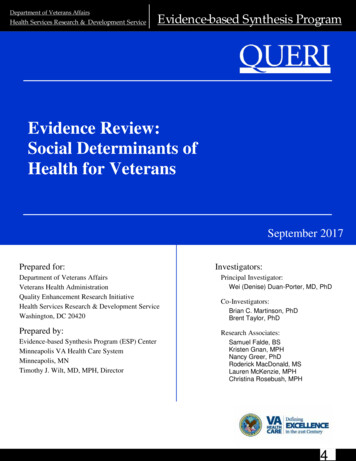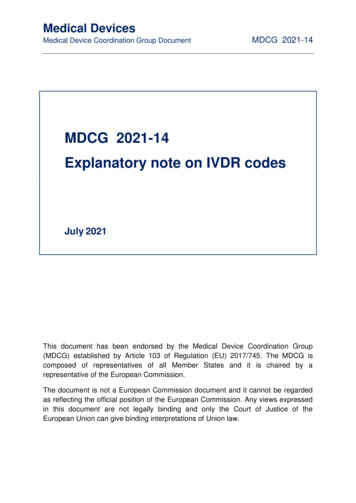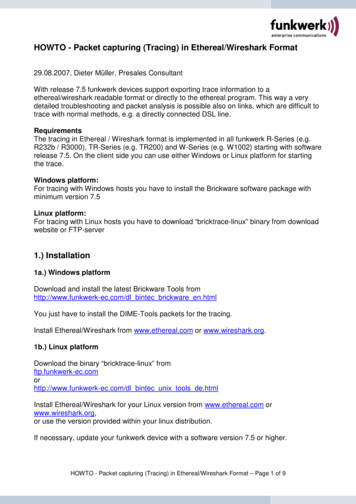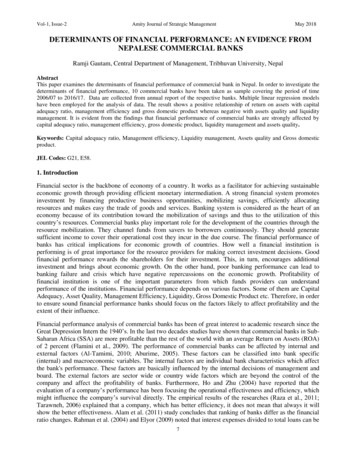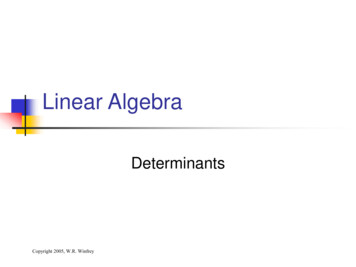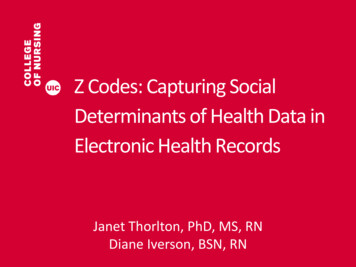
Transcription
Z Codes: Capturing SocialDeterminants of Health Data inElectronic Health RecordsJanet Thorlton, PhD, MS, RNDiane Iverson, BSN, RN
Objectives Describe the difference between ICD-10CM/PCS procedure codes and diagnosis codes Locate and list 3 of the various categories of Zcodes. Describe possible reasons for underutilizationof Z codes for capturing social determinants ofhealth (SDH) data.2
Background World Health Organization authorized publication ofthe International Classification of Diseases (ICD-10)1– implemented for mortality coding /classification of deathcertificates since 1999– Allows for comparison of US morbidity diagnosis data atthe international level– In 2015, the Dept. of Health & Human Services mandatedthat all entities covered by HIPAA must transition to ICD10-CM/PCS for electronic health record transactions 13
Benefits of ICD-10-CMThis classification system provides data for 2: Monitoring resource use Tracking public health and risks Measuring quality, safety, & efficacy of care Conducting research, epidemiological studies,clinical trials Strategic planning Setting health policy4
What’s the Difference?ICD-10-CM(Clinical Modification) Developed for medicaldiagnosis coding for all UShealthcare settings1 69,000 diagnosis codes provides categories of codesreflecting patients’ socialcharacteristics and reasonfor encounter in the form of“Z-codes”ICD-10-PCS(Procedure Coding System) Developed for hospitalinpatient procedures1 71,000 procedure codes is a completely separatemedical coding system fromICD-10-CM.5
What is a Z-Code? A special group of codes provided in ICD-10-CM 3– Factors influencing health status and contact withhealth services: Z00 – Z99. Z-Codes represent reasons for encounters Underutilized resource for tracking social needs The mandate for ICD-10-CM adoption creates anattractive standardized approach for dataaggregation, via coding and billing for SDH6
What are Social Determinants of Health?5 SDH represent the interrelationships among personal, social,economic, and environmental factors that influence patienthealth status 4 SDH data can inform clinical decision making, creating strategiesfor improving population health, potentially reducing utilizationof overcrowded emergency departments 47
Codes Z55-Z65:Persons with potential health hazards related tosocioeconomic and psychosocial circumstancesZ55 Problems related to education and literacyZ56 Problems related to employment and unemploymentZ57 Occupational exposure to risk factorsZ59 Problems related to housing & socioeconomic circumstancesZ60 Problems related to social environmentZ62 Problems related to upbringing; parental issuesZ63 Other problems related to primary support group, including family circumstancesZ64 Problems related to certain psychosocial circumstancesZ65 Problems related to other psychosocial circumstancesSee all the Z codes6 on your mobile Z998
MethodsExperiences of a Nursing Case Manager from aBaltimore Emergency Dept., where high rates ofhomeless individuals turn for services, promptedthe question:What factors influence the inclusion and captureof social determinants of health data inelectronic health records?9
MethodsUsing a basic processfor gap analysis, weexamined current anddesired states, andtook steps towardaccomplishing thedesired state:capturing SDH data inthe medical codingprocess.CurrentStateGapAnalysisHow do wedo this?DesiredStatewhat do wewant toachieve?where arewe now?10
Current State Healthy People 2020 selected SDH as anindicator to assess the nation’s health and tomotivate action on local, state, and nationallevels to improve population health5. Though designated as a high priority indicator,over 30% of SDH objectives have gotten worseor haven’t changed since 2010, indicatingmore progress is needed5.11
2017 Homeless Data: MarylandAnnual 5 2016 2017 2,165 homeless Veterans 1, 370 children 18 422 youth ages 18-24 11% flee domestic violence 5,511 are sheltered 1,736 not sheltered Deaths of homeless havemore than doubled since200712
Costs of Homelessness Nearly one-third of all visits to the emergency roomare made by people struggling with chronichomelessness11-12 On average, they visit the emergency room 5 times/yr– The highest users visit weekly 11 Some studies have found that leaving a person toremain chronically homeless costs taxpayers as muchas 30,000 to 50,000 per year 12 80% of emergency room visits made by peoplestruggling with homelessness are for an illness thatcould have been treated with preventative care 1113
Current State When documenting in the EHR, physicians and nursesshare patient information; however, they describe thatinformation differently8-9– Physician entries emphasize diagnosis, treatment,and management– Nursing entries emphasize functional issues Even when SDH are documented in ancillary notes,this information may not necessarily be captured bymedical coders or software programs, for variousreasons, including software limitations8-9.14
Current State Medical coders may be incentivized to meet quotas A focus on medical diagnoses and other criteriamay result in lack of coding SDH data8-9 Coding of functional issues may have littleperceived value 8-9 MD / mid-level provider entries are captured in thecoding process, however, software programs mayneed to be updated to capture and assign Z-codesto SDH information located in ancillary notes 8-915
Desired State use non-physician, ancillary entries forassigning Z codes to SDH information ensure that electronic health record softwareupdates capture this information Capture SDH data to inform policy, developprograms to improve population health16
Steps for Reaching the Desired State The AHA Coding Clinic is the official resource and authorityfor ICD-10-CM/PCS coding rules and conventions 10 All questions submitted are processed free of charge, butregistration is required10– The AHA Central Office is a Clearinghouse Service established withthe Dept. of HHS to provide free assistance– Does not replace learning how to code; not a hotline service https://www.codingclinicadvisor.com/17
Steps for Reaching the Desired State Categories Z55-Z65 contain codes pertaining to:Persons with potential health hazards related tosocioeconomic and psychosocial circumstances This important information is typically only found innurses or social worker documentation.The Nurse Case Manager posed this question to theAHA Coding Clinic Advisory Board:Is it appropriate to use non-physiciandocumentation to assign codes that provideinformation on social determinants of health?18
Gap Analysis ResultsThe AHA Advisory Board responded The ruling now states that for ICD-10-CMcategories Z55-Z65, persons with potential healthhazards related to socioeconomic andpsychosocial circumstances, represent socialinformation, rather than medical diagnoses. As such, it is acceptable to report Z codes basedon information documented by other cliniciansinvolved in the care of the patient.19
Implications for Practice & Conclusion SDH correlate with health outcomes & risks– Data can inform decision making– potential for treating with preventive care Z-coded data captured from nurse and socialworker notes, will contribute data forepidemiological research– More precise identification, tracking of SDH Policy implications– Potential for more low-barrier shelter options;reduced ER visits?20
MAP-IT: Guide to Using Healthy People 2020 inYour Community13 Healthy People is based on a simple but powerfulmodel:– Establish national health objectives.– Provide data & tools to enable states, cities,communities, and individuals across the Nation tocombine their efforts to achieve them. Use the MAP-IT framework to helpMobilizeAssessPlanImplementTrack21
Questions?Janet Thorltonthorlton@uic.eduDiane Iversond.iverson1@gmail.com22
References1. Centers for Disease Control & Prevention (2015). International Classification of Diseases,(ICD-10-CM/PCS) transition – background. Retrieved from:https://www.cdc.gov/nchs/icd/icd10cm pcs background.htm2. Dept. of Health & Human Services. Medicare Learning Network (2017). Diagnosis Coding:Using the ICD-10-CM. Retrieved from 0wbt textonly 508.pdf.3. ICD10Data.com (2018). Factors influencing health status and contact with health servicesZ00-Z99. Retrieved from: https://www.icd10data.com/ICD10CM/Codes/Z00-Z994. Lexis Nexis Risk Solutions (2017). White paper: Social determinants of health fuel deeperunderstanding of health risks and ability to proactively impact health outcomes.5. U.S. Dept. of Health & Human Services. Office of Disease Prevention and Health Promotion.Healthy People 2020: Social determinants of health. Image ons-resources6. ICD-10-CM Codes (2018). Factors influencing health status and contact with health servicesZ00-Z99. Retrieved from: http://www.icd10data.com/ICD10CM/Codes/Z00-Z997. Maryland Interagency Council on Homelessness (2017, Nov. 7). 2017 Annual report onhomelessness. Retrieved 2017AnnualReport.pdf23
References (cont’d)8. Goar, E.S. (2017, May). Don’t sleep on Z codes: Is the industry taking advantage ofthis group of codes as a tool to collect social determinant data? For the Record,29(5):14-17. Retrieved 4.shtml.9. Gottlieb, L., Tobey, R., Cantor, J., Hessler, & Adler, N.E. (2016). Integrating social andmedical data to improve population health: Opportunities and barriers. HealthAffairs, 35(11), 2116-2123. doi: 10.1377/hlthaff.2016.0723.10. American Hospital Association (2018). AHA Coding Clinic Advisor. Available at:https://www.codingclinicadvisor.com/11. Green Doors (2008). The cost of homelessness facts. Retrieved from:http://greendoors.org/facts/cost.php12. US Interagency Council on Homelessness. Ending chronic homelessness in 2017.https://www.usich.gov/resources/uploads/asset library/Ending Chronic Homelessness in 2017.pdf13. U.S. Dept. of Health & Human Services. Office of Disease Prevention and HealthPromotion. Healthy People 2020: Program Planning. Available sources/Program-Planning24
Even when SDH are documented in ancillary notes, this information may not necessarily be captured by . White paper: Social determinants of health fuel deeper understanding of health risks and ability to proactively impact health outcomes. 5. U.S. Dept. of Health & Human Services. Office of Disease Prevention and Health Promotion.
